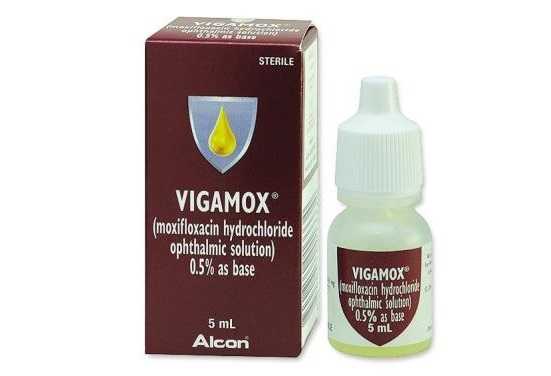
Vigamox Eye Drops ( Moxifloxacin Eye Drops )
Vigamox Eye Drops ( Moxifloxacin Eye Drops ) is a member of fourth-generation of fluoroquinolone. It is approved by FDA for the treatment of bacterial conjunctivitis.
Ingredients of Vigamox Eye Drops
Active ingredients
Moxifloxacin 0.5% (5 mg/mL); Each mL of Vigamox ophthalmic solution contains 5.45 mg moxifloxacin hydrochloride which is equivalent to 5 mg moxifloxacin base.
Inactive Ingredients
Boric acid, sodium chloride, and purified water. It also contains Hydrochloric acid or sodium hydroxide to adjust pH to approximately 6.8.
Preservatives
Free
Storage
Store at 2°C - 25°C (36°F - 77°F). Discard four weeks after first opening. Keep it away from sunlight and moisture. Keep it away from children and pets.
Indications of Vigamox Eye Drops ( Moxifloxacin Eye Drops)
Vigamox Eye Drops is used to treat bacterial eye infections mainly bacterial conjunctivitis. It can be used post ocular surgeries such as lasik, Phaco surgery and Vitrectomy. It can be used also in the treatment of corneal ulcer. It has broad spectrum antibacterial activity. It acts against gram positive, gram negative and also can act against Chlamydia.
Mechanism of action
Moxifloxacin eye drops inhibit topoisomerase II (DNA gyrase) and topoisomerase IV enzymes which are required for bacterial DNA replication, transcription, repair, and recombination.
Contraindications
It should not be used in patients with a history of hypersensitivity to moxifloxacin, to other quinolones, or to any of its ingredients.
Dosage
The recommendation dose is one eye drop in the infected eye, three times a day for 7 days. You eye doctor can change this regimen according to your condition. You should continue using this eye drop exactly as prescribed by your doctor, even if you have started to feel better.
Pregnancy and Nursing Mothers
It should be used during pregnancy only if the potential benefit justifies the potential risk to the fetus because there are no adequate and well-controlled studies in pregnant women. It is presumed that moxifloxacin is excreted in human milk but it has not been measured It should be used with caution in nursing mothers.
Pediatric Use
The safety and effectiveness in children below 1 year of age have not been established. Oral administration of some quinolones has been shown to cause arthropathy in immature animals but there is no evidence that the ophthalmic administration of moxifloxacin has any effect on weight bearing joints of children.
Geriatric Use
No overall differences in safety and effectiveness have been observed between elderly and young patients.
Side Effects of Vigamox Eye Drops ( Moxifloxacin Eye Drops)
Common ocular side effects that occur can occur in 1-6% of patients:
1- Burning sensation.
2- Dry eye.
3- Red eye and subconjunctival hemorrhage.
4- Itchy eye.
5- Transient blurred vision.
6- Eye pain.
7- Corneal inflammation or keratitis.
Systemic side effects that occur in 1-4% of patients:
1- Headache.
2- Bad taste after instillation.
3- Fever.
4- Cough.
5- Otitis Media.
6- Pharyngitis.
7- Rash.
8- Rhinitis.
If you notice any of these side effects you should you should tell your eye doctor about it. If you notice any unusual side effects such as skin rash, skin itching, face, tongue or throat swelling, dizziness and breathing difficulties, you should stop the medication and contact your eye doctor immediately.


